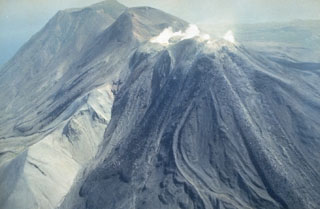Report on Moyorodake [Medvezhia] (Japan - administered by Russia) — August 1995
Bulletin of the Global Volcanism Network, vol. 20, no. 10 (August 1995)
Managing Editor: Richard Wunderman.
Moyorodake [Medvezhia] (Japan - administered by Russia) Measurements of SO2 in Kudriavy plume
Please cite this report as:
Global Volcanism Program, 1995. Report on Moyorodake [Medvezhia] (Japan - administered by Russia) (Wunderman, R., ed.). Bulletin of the Global Volcanism Network, 20:10. Smithsonian Institution. https://doi.org/10.5479/si.GVP.BGVN199508-290100
Moyorodake [Medvezhia]
Japan - administered by Russia
45.389°N, 148.838°E; summit elev. 1124 m
All times are local (unless otherwise noted)
The Kudriavy cone at Medvezhia has been the subject of great interest since Korzhinsky and others (1994) discovered a pure rhenium sulfide mineral in its high-temperature (535°C) fumaroles. Given the concentration of Re found in gas samples (2-10 ppb), the occurrence of ReS2 or Re2S3 (exact form still uncertain) requires enrichment of Re by eight orders of magnitude. During a 21 August-5 September visit, Stan Williams, Tobias Fisher, and Russian colleagues made COSPEC measurements of SO2 flux. Gas samples were also collected from crater fumaroles.
The COSPEC was operated from the base camp (150 m elevation) 2.7 km SE of the elongate ENE-WSW summit (990 m elevation), while the wind velocity was measured at the summit using a hand-held anemometer. The first measurements were made on 28 August in vertically oriented stationary mode with the wind blowing the wide gas plume directly over the camp. Wind velocity was measured at 3 m/s and the plume was estimated to be rising only 50 m above the summit before being blown downwind. The flux was found to be 100 +- 20 metric tons/day (t/d) for the three measurements possible before the wind shifted to the SW, making any measurements essentially oblique to the plume axis, and therefore of great uncertainty. An occasional strong odor of H2S was detected at the camp during measurements.
During a crater visits on 29 and 31 August, and during a helicopter flight downwind in the plume, there was always a strong odor of H2S. Under clear skies on 31 August the wind carried the plume SW, allowing stationary mode vertical and horizontal measurements. One specific goal of the research was to quantify the output of the isolated fumarole fields with different temperatures, which was possible for part of the day. Wind velocity was measured at 3 m/s and the SO2 flux was calculated to be only 30 +- 10 t/d.
Kudriavy has been consistently degassing passively at high temperatures since at least 1961, when it was first visited by Russian scientists; annual fieldwork began in 1989. No change in activity was noted during this visit. At the low levels at which Kudriavy was found to be degassing, a realistic SO2 norm may be 75 +- 50 t/d, with the oscillations potentially reflecting meteoric conditions. These low-pressure fumaroles, some with temperatures up to 950°C, produced hissing to roaring to deafening levels of noise. There was more noise and higher flux than at Momotombo (Nicaragua), where 950°C fumaroles were studied through the early to mid-1980s by U.S. and Russian collaboration.
Reference. Korzhinsky, M.A., Tkachenko, S.I., Shmulovich, K.I., Taran, Y.A., and Steinberg, G.S., 1994, Discovery of a pure rhenium mineral at Kudriavy volcano: Nature, v. 369, p. 51-52.
Geological Summary. The Moyorodake volcanic complex (also known as Medvezhia) occupies the NE end of Iturup (Etorofu) Island. Two overlapping calderas, 14 x 18 and 10 x 12 km in diameter, were formed during the Pleistocene. The caldera floor contains several lava domes, cinder cones and associated lava fields, and a small lake. Four small closely spaced stratovolcanoes were constructed along an E-W line on the eastern side of the complex. The easternmost and highest, Medvezhii, lies outside the western caldera, along the Pacific coast. Srednii, Tukap, and Kudriavy (Moyorodake) volcanoes lie immediately to the west. Historically active Moyorodake is younger than 2000 years; it and Tukap remain fumarolically active. The westernmost of the post-caldera cones, Menshoi Brat, is a large lava dome with flank scoria cones, one of which has produced a series of young lava flows up to 4.5 km long that reached Slavnoe Lake. Eruptions have been documented since the 18th century, although lava flows from cinder cones on the flanks of Menshoi Brat were also probably erupted within the past few centuries.
Information Contacts: Stanley N. Williams and Tobias P. Fischer, Geology Dept., Arizona State University, Tempe AZ 85287, USA; Kirill I. Shmulovich and Mikhail A. Korzhinsky, Inst. of Experimental Mineralogy, Russian Academy of Sciences, 142432 Chernogolovka, Moscow District, Russia; Genrikh S. Steinberg, Inst. of Volcanology & Geodynamic ANSRF, 693008 Yuzhno-Sakhalinsk, Box 18, Russia.

